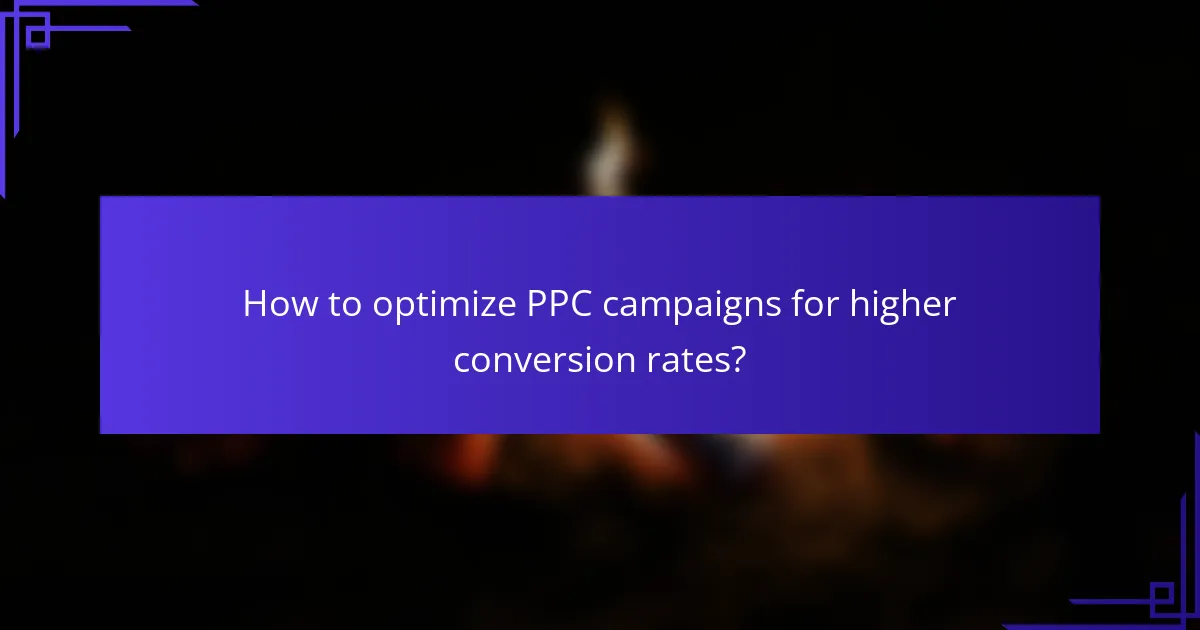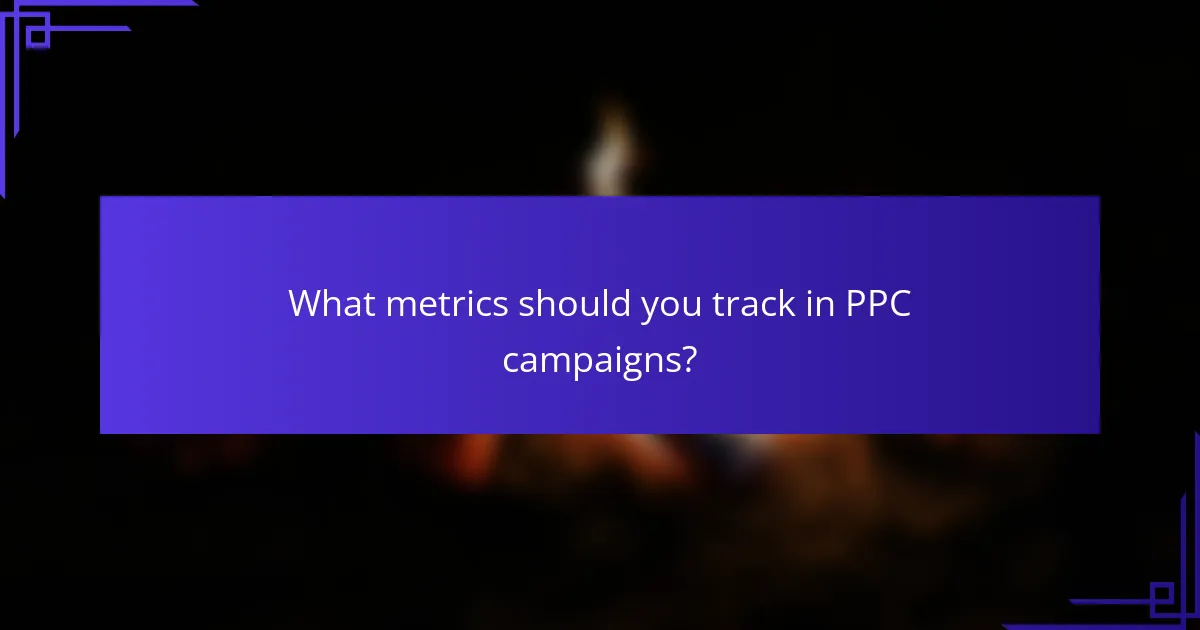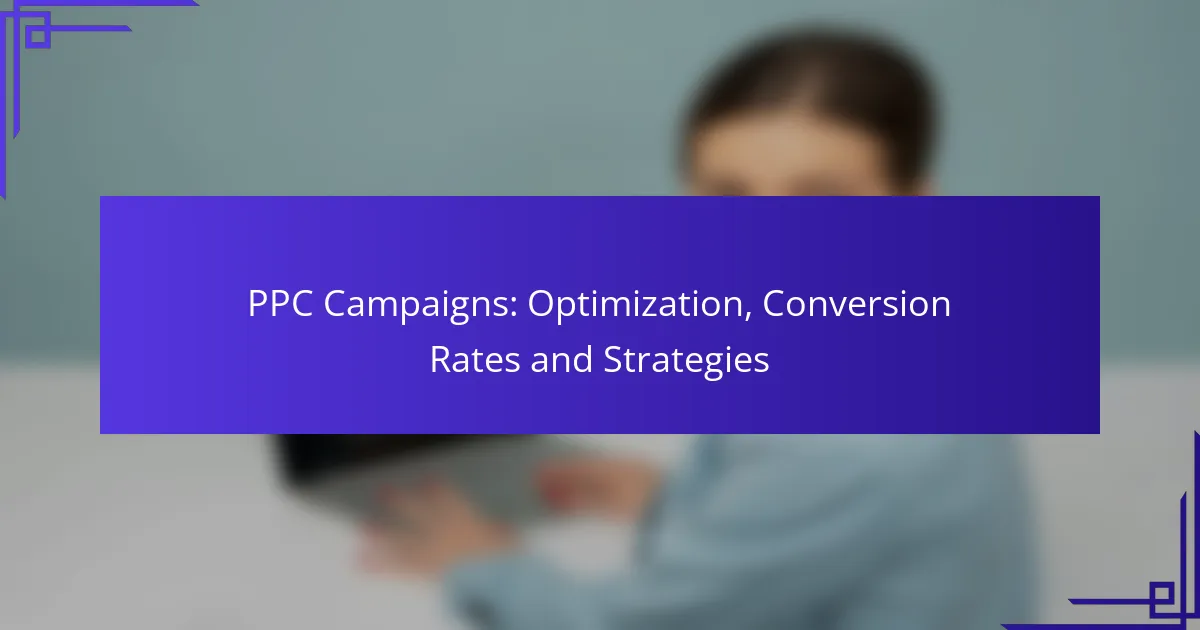PPC campaigns are a powerful tool for driving traffic and generating leads, but their success hinges on effective optimization strategies. By refining keyword targeting, enhancing ad copy, and improving landing pages, advertisers can significantly boost conversion rates. Additionally, systematic A/B testing and diligent bid management are crucial for maximizing campaign performance and achieving desired results.

How to optimize PPC campaigns for higher conversion rates?
To optimize PPC campaigns for higher conversion rates, focus on refining keyword targeting, enhancing ad copy, and improving landing pages. Implementing systematic A/B testing and effective bid management can further elevate performance and drive better results.
Keyword targeting strategies
Effective keyword targeting is crucial for reaching the right audience. Start by conducting thorough keyword research to identify high-intent keywords that align with your offerings. Utilize tools like Google Keyword Planner to discover relevant terms and phrases that potential customers are searching for.
Consider using long-tail keywords, as they often have lower competition and higher conversion rates. For example, instead of targeting “shoes,” focus on “men’s running shoes for flat feet.” This specificity can lead to more qualified traffic.
Ad copy improvements
Ad copy plays a vital role in attracting clicks and driving conversions. Craft compelling headlines that grab attention and clearly communicate the value proposition. Use action-oriented language and include a strong call to action, such as “Shop Now” or “Get Your Free Trial.”
Incorporate relevant keywords into your ad copy to improve Quality Score and ensure your ads resonate with search intent. Regularly test different variations of your ad copy to identify what works best for your audience.
Landing page optimization
Landing pages must align with the ad copy and provide a seamless user experience. Ensure that the landing page loads quickly, ideally within a few seconds, to reduce bounce rates. Use clear headlines, concise content, and visually appealing layouts to engage visitors.
Incorporate trust signals, such as customer testimonials or security badges, to enhance credibility. A/B test different elements of your landing page, such as images and calls to action, to determine which combinations yield the highest conversion rates.
A/B testing methodologies
A/B testing allows you to compare different versions of ads or landing pages to see which performs better. Start by identifying a single variable to test, such as the headline or call to action, and create two versions: A and B.
Run the test for a sufficient duration to gather meaningful data, typically a few weeks, and analyze the results to determine which version drives more conversions. Use these insights to inform future optimizations and continuously improve your campaigns.
Bid management techniques
Effective bid management is essential for maximizing your PPC budget and improving conversion rates. Consider using automated bidding strategies, such as Target CPA or Maximize Conversions, which adjust bids based on performance data to achieve your goals.
Regularly review and adjust your bids based on keyword performance. Increase bids for high-performing keywords that drive conversions, while reducing bids or pausing underperforming keywords to allocate budget more effectively.

What are the best PPC platforms for lead generation?
The best PPC platforms for lead generation include Google Ads, Bing Ads, Facebook Ads, and LinkedIn Ads. Each platform offers unique features and targeting capabilities that can significantly impact your lead generation efforts.
Google Ads effectiveness
Google Ads is highly effective for lead generation due to its extensive reach and robust targeting options. Advertisers can target specific keywords, demographics, and locations, making it easier to connect with potential leads actively searching for products or services.
To maximize effectiveness, focus on creating compelling ad copy and optimizing landing pages for conversions. Regularly analyze performance metrics to adjust bids and improve ad relevance, ensuring you achieve a good return on investment.
Bing Ads advantages
Bing Ads can be a cost-effective alternative to Google Ads, often featuring lower competition and click costs. This platform allows advertisers to reach a different audience, particularly among users who prefer Microsoft products.
Consider utilizing Bing Ads if your target demographic includes older adults or businesses, as these users tend to favor Bing. Additionally, take advantage of Bing’s integration with LinkedIn for enhanced targeting options.
Facebook Ads targeting
Facebook Ads excels in precise targeting based on user interests, behaviors, and demographics. This allows businesses to reach specific audiences that align closely with their ideal customer profiles.
Utilize Facebook’s custom audiences feature to retarget previous website visitors or engage with users who have interacted with your content. Experiment with various ad formats, such as carousel or video ads, to capture attention and drive conversions.
LinkedIn Ads for B2B
LinkedIn Ads is particularly effective for B2B lead generation, allowing businesses to target professionals based on industry, job title, and company size. This platform is ideal for promoting services and products tailored to other businesses.
When using LinkedIn Ads, focus on creating informative content that addresses the needs of your target audience. Sponsored content and InMail campaigns can be particularly effective in generating high-quality leads in a professional context.

What metrics should you track in PPC campaigns?
Tracking key metrics in PPC campaigns is essential for understanding performance and optimizing results. Focus on metrics that reflect user engagement and conversion effectiveness to make informed decisions about your advertising strategy.
Click-through rate (CTR)
Click-through rate (CTR) measures the percentage of users who click on your ad after seeing it. A higher CTR indicates that your ad is relevant and appealing to your target audience. Aim for a CTR of around 2-5% as a general benchmark, but this can vary by industry.
To improve CTR, consider testing different ad copy, headlines, and calls to action. Regularly analyze which ads perform best and refine your approach based on user behavior.
Conversion rate analysis
Conversion rate analysis evaluates the percentage of users who complete a desired action after clicking your ad, such as making a purchase or signing up for a newsletter. A typical conversion rate ranges from 1-5%, depending on the industry and campaign goals.
To enhance conversion rates, ensure your landing pages are optimized for user experience and aligned with the ad’s messaging. A/B testing different landing page designs can help identify what resonates best with your audience.
Cost per acquisition (CPA)
Cost per acquisition (CPA) measures the total cost of acquiring a customer through your PPC campaigns. This metric helps you understand the financial efficiency of your advertising efforts. A desirable CPA should be lower than the average revenue generated per customer.
To manage CPA effectively, set clear budgets and monitor spending closely. Adjust bids and targeting based on performance to ensure you are maximizing your return on investment.
Return on ad spend (ROAS)
Return on ad spend (ROAS) calculates the revenue generated for every dollar spent on advertising. A ROAS of 4:1 is often considered a good target, meaning you earn four dollars for every dollar spent. This metric is crucial for assessing the profitability of your PPC campaigns.
To improve ROAS, focus on optimizing your ad targeting and refining your keyword strategy. Regularly review performance data to identify high-performing ads and allocate more budget to them while reducing spend on underperforming ones.

What are common pitfalls in PPC campaigns?
Common pitfalls in PPC campaigns can significantly hinder their effectiveness and return on investment. Avoiding these mistakes is crucial for optimizing performance and maximizing conversion rates.
Ignoring negative keywords
Ignoring negative keywords can lead to wasted ad spend and irrelevant clicks. Negative keywords prevent your ads from showing up for specific search terms that are not relevant to your offerings, ensuring that your budget is spent more efficiently.
To effectively use negative keywords, regularly analyze your search term reports and identify terms that trigger your ads but do not convert. Implementing a list of negative keywords can help refine your audience and improve your campaign’s overall performance.
Overlooking mobile optimization
Overlooking mobile optimization can severely limit your PPC campaign’s reach and effectiveness. With a significant portion of users accessing ads via mobile devices, ensuring that your landing pages are mobile-friendly is essential for capturing conversions.
To optimize for mobile, ensure that your website loads quickly, has a responsive design, and features easy navigation. Consider using mobile-specific ad formats and extensions to enhance user experience and drive higher engagement rates.
Not using ad extensions
Not using ad extensions can result in missed opportunities to enhance your ad visibility and click-through rates. Ad extensions provide additional information about your business, such as location, phone number, and links to specific pages, making your ads more appealing.
Incorporate various ad extensions, such as site link extensions, call extensions, and location extensions, to provide users with more reasons to click on your ads. This can lead to improved ad rankings and increased conversion rates, making your PPC efforts more effective.

How to create a PPC budget effectively?
Creating a PPC budget effectively involves determining your overall marketing goals, understanding your target audience, and allocating funds based on expected returns. A well-structured budget helps optimize your campaigns and maximize conversion rates.
Determine your goals
Establish clear objectives for your PPC campaigns, such as increasing website traffic, generating leads, or boosting sales. These goals will guide your budget allocation and help you measure success. For example, if your aim is to generate leads, you might allocate more funds to keywords that have historically converted well.
Analyze historical data
Review past PPC campaign performance to identify trends and insights. Look at metrics like cost-per-click (CPC), conversion rates, and return on ad spend (ROAS). This analysis will inform your budget decisions, allowing you to allocate more resources to high-performing keywords while reducing spend on underperformers.
Set a realistic budget
Your PPC budget should reflect your business’s financial capacity and marketing goals. A common approach is to allocate a percentage of your overall revenue or marketing budget to PPC, often ranging from 5% to 20%. Ensure that your budget allows for flexibility to adjust based on campaign performance and market conditions.
Monitor and adjust
Regularly review your PPC campaigns to assess their performance against your goals. Use analytics tools to track key metrics and make data-driven adjustments to your budget. If certain campaigns are performing exceptionally well, consider reallocating funds from lower-performing areas to maximize your return on investment.
